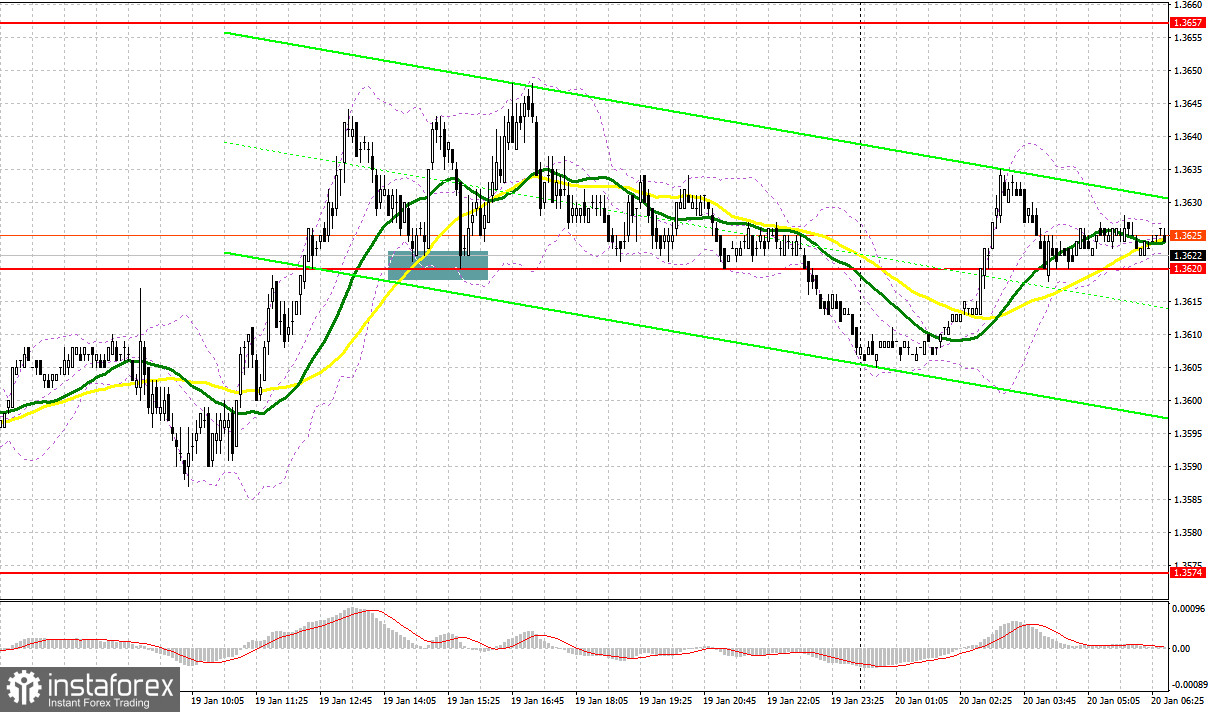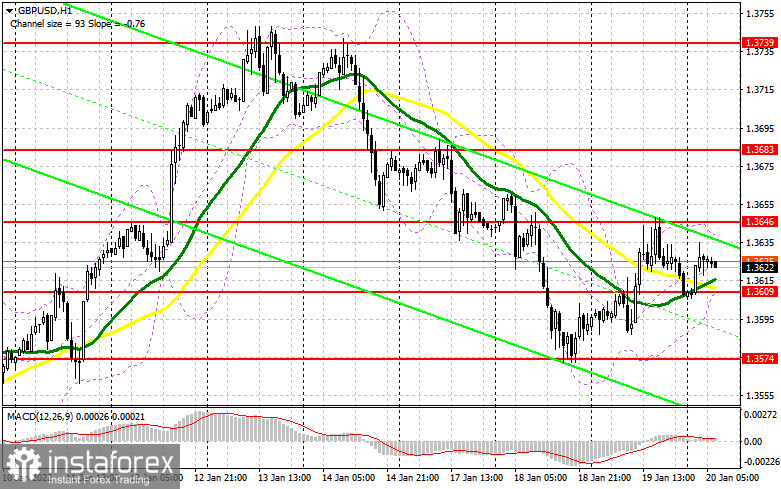To open long positions on GBP/USD, you need:
Yesterday, several good signals were formed to buy the pound in the afternoon. Let's take a look at the 5-minute chart and figure out what happened. There was nothing interesting during the European session. Only by the middle of the day, after the bulls' reaction to the data on sharp inflationary pressure in the UK, the bulls managed to cross the resistance of 1.3620, which preserved the chance for a further upward correction of the pair in the short term. During the US session, we watched the 1.3620 level tested from top to bottom, which resulted in forming signals to buy the pound. As a result, the growth was about 30 points.

Yesterday's speech by Bank of England Governor Andrew Bailey, made it clear with what concern the central bank treats the current increase in inflation in the UK. This keeps a fairly good chance of a more aggressive policy of the BoE in relation to interest rates, which makes the British pound attractive in the medium term. The main goal for today is to control the new resistance of 1.3646, as the pair failed to rise above it yesterday. Another equally important task is to protect the support of 1.3609 – by missing it, you can say goodbye to the pound's growth in the short term. A false breakout at 1.3609, and there are moving averages playing on the bulls' side, creates the first buy signal with the prospect of continuing the bull market aimed at growth above 1.3646. Only a breakthrough and a test of this level from above will strengthen bulls' position, which will provide an additional entry point into long positions in order to return to the highs: 1.3683 and 1.3739, where I recommend taking profits. In case GBP/USD falls during the European session against the background of weak data on the balance of industrial orders from the Confederation of British Industry and the lack of activity at 1.3609, it is best to postpone long positions to the level of 1.3574, from where it will be possible to observe more aggressive actions from the bulls - this is their last chance to keep the market under their control in the short term. To miss this area is tantamount to missing the initiative. Forming a false breakout at 1.3574 will provide an entry point in hopes of further recovery of GBP/USD. You can buy the pound immediately on a rebound from 1.3532, or even lower - from a low like 1.3496, counting on a correction of 20-25 points within the day.
To open short positions on GBP/USD, you need:
The bears retreated after yesterday's inflation data and Bailey's statements, and now it is very important how much panic sentiment associated with an increase in interest rates in the United States will rise - who will overpower, in that direction the pair will move in the short term. The primary task for today is to protect the rather important resistance of 1.3646, going beyond which can significantly hit the bears' plans for a further decline in the pound. Forming a false breakout at this level creates the first entry point into short positions, followed by a decline to the area of 1.3609, where the moving averages are playing on the bulls' side. Weak data on the UK and taking control of this level will provide a new entry point into short positions, counting on the decline of GBP/USD by 1.3574 and 1.3532, where I recommend taking profits. If the pair grows during the European session and bears are weak at 1.3646, it is best to postpone short positions until the next major resistance at 1.3683. I also advise you to open short positions there only in case of a false breakout. You can sell GBP/USD immediately for a rebound from 1.3739, or even higher - from this month's high in the area of 1.3790, counting on the pair's rebound down by 20-25 points within the day.

I recommend for review:
The Commitment of Traders (COT) reports for January 11 revealed that long positions had increased while short positions decreased - which indicates the pound's appeal after the Bank of England raised interest rates at the end of 2021. If you look at the overall picture, the prospects for the British pound look pretty good, and the observed downward correction makes it more attractive. The BoE's decisions continue to support buyers of risky assets in the expectation that the central bank will continue to raise interest rates this year, which will push the pound even higher. High inflation is still the main reason why the BoE will continue to tighten monetary policy. Last week, Federal Reserve Chairman Jerome Powell said that he would not shape events and rush to raise interest rates, especially in view of the sharp decline in retail sales in December 2021, which should cool down inflationary pressure a little. This led to a decrease in demand for the US dollar, which will allow pound bulls to continue building an upward trend. The COT report for January 11 indicated that long non-commercial positions increased from the level of 25,980 to the level of 30,506, while short non-commercial positions decreased from the level of 65,151 to the level of 59,672. This led to a change in the negative non-commercial net position from -39,171 to -29,166. The weekly closing price rose from 1.3482 to 13579.
Indicator signals:
Trading is above 30 and 50 moving averages, which indicates an attempt by the bulls to seize the initiative.
Moving averages
Note: The period and prices of moving averages are considered by the author on the H1 hourly chart and differs from the general definition of the classic daily moving averages on the daily D1 chart.
Bollinger Bands
In case of growth, the upper border of the indicator around 1.3646 will act as resistance. In case of a decline, the lower border of the indicator in the area of 1.3609 will act as support.
Description of indicators
- Moving average (moving average, determines the current trend by smoothing out volatility and noise). Period 50. It is marked in yellow on the chart.
- Moving average (moving average, determines the current trend by smoothing out volatility and noise). Period 30. It is marked in green on the chart.
- MACD indicator (Moving Average Convergence/Divergence — convergence/divergence of moving averages) Quick EMA period 12. Slow EMA period to 26. SMA period 9
- Bollinger Bands (Bollinger Bands). Period 20
- Non-commercial speculative traders, such as individual traders, hedge funds, and large institutions that use the futures market for speculative purposes and meet certain requirements.
- Long non-commercial positions represent the total long open position of non-commercial traders.
- Short non-commercial positions represent the total short open position of non-commercial traders.
- Total non-commercial net position is the difference between short and long positions of non-commercial traders.
 English
English 
 Русский
Русский Bahasa Indonesia
Bahasa Indonesia Bahasa Malay
Bahasa Malay ไทย
ไทย Español
Español Deutsch
Deutsch Български
Български Français
Français Tiếng Việt
Tiếng Việt 中文
中文 বাংলা
বাংলা हिन्दी
हिन्दी Čeština
Čeština Українська
Українська Română
Română

